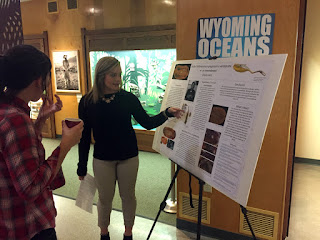---by Dennis H. Knight
Former students, colleagues, conservationists, and many friends were saddened to learn that UW Professor Emerita Martha Christensen passed away on March 19th in Madison, Wisconsin. She was 85 and fully enjoying her retirement years, driving her elderly friends to their appointments in her solar-powered Chevrolet Volt, entertaining visitors with her easy laugh and warm interest in their activities, joining friends on frequent bird-watching trips, and serving on an advisory board for the University of Wisconsin Arboretum. Martha retired from our department in 1989, but she continued to study her incomparable collection of soil micro-fungi with the support of the Pfizer Corporation and the National Science Foundation. Her last publication, in 2011, was titled,
Soil fungi: a new perspective. In 2013 she received the prestigious Johanna Westerdijk Award from the
Westerdijk Fungal Biodiversity Institute of the Royal Netherlands Academy of Arts and Sciences.
Martha came to the University of Wyoming in 1963 after receiving her Ph.D. in fungal ecology at the University of Wisconsin-Madison. She was the first woman to join the Botany Department faculty. In the first year she taught mycology, dendrology, plant morphology, and general botany. There was essentially no time for research during those early years, but Martha’s persistence and abilities led to her being elected president of the Mycological Society of America in 1988. Other honors included “Woman of the Year” from the University of Wyoming Student Association (1971), the William A. Weston Award for Teaching Excellence from the Mycological Society of America (1991), and the Outstanding Former Faculty Award from the UW College of Arts and Sciences (1997). She was a generous supporter of our department, initiating endowments for the H.T. Northen Summer Fellowship and the C.L. Porter Summer Fellowship.
A world-renowned expert on
Penicillium and
Aspergillus, Martha examined soil micro-fungi in different types of soils and in different kinds of plant communities, finding many new species. She also studied mycorrhizal fungi, the fungal diseases of honey bees and bats, microbial sources of ice nuclei in clouds, fungi as indicators of past environments, and the fungal component of soil crusts in deserts. Supported by numerous grants, she published over 60 research papers and served as a mentor for 22 graduate students. Her students (listed below) were employed by Humboldt State University, Northern Arizona University, San Diego State University, University of California-Riverside, University of Colorado, University of South Florida, University of Wyoming, Coors Brewing Company, Scotts Lawn Care, and various community colleges, public schools, businesses and consulting firms.
Martha had a way with words. In an essay published in 2011, she described an experience that occurred when she delivered her collection of fungal isolates to a world-class depository in the Netherlands (Centraalbureau voor Schimelcultures). For the first two sentences she wrote, “New habitats create new species, I declared—as though it was a newly discovered phenomenon. My host remained quiet for a moment, and that in part may explain why I remember the occasion so well.”
As another example: “I was hired [at UW] after Dr. Bill Solheim [her predecessor in mycology] heard me give a talk on
Mortierella vinacea—a beautiful little fungus that lives and works in forest soils. Perhaps I had an edge over the other applicants because I played the viola. The Solheims and Northens liked classical music and apparently there were only three other violists in Laramie at the time! At the first orchestra rehearsal, I was seated in the first chair! Music at UW was fun for me during the next 30 years.”
Martha had a deep interest in classical music, playing in orchestras wherever she lived. And, to the delight of everyone, she played tunes on an ordinary saw at Botany Department parties.
Aside from fungi and music, Martha was an avid outdoors person, backpacking into wilderness areas and taking bird-watching trips to Africa, South America, Australia and Europe. She was also a bold watchdog of how Wyoming public lands were being managed. With frequent letters to the editor and reviews of National Forest management plans, she was admired for her tenacity in keeping land managers honest about their management decisions. In one of her letters about forest management she quoted Goethe (1749-1832), who wrote, “Nothing is more terrible than ignorance in action.” In another she urged readers to ask for the protection of all remaining roadless and wilderness areas in our national forests.
Martha was a generous member and leader of numerous conservation organizations, and she was featured in the book,
Ahead of Their Time: Wyoming Voices for Wilderness.
Her family suggests that memorials be sent to
The Nature Conservancy or the
Wyoming Outdoor Council.
Martha is survived by her twin brother, Dr. James Christensen, and his wife Carol of North Liberty, Iowa, and two nieces and a nephew and their families. An obituary can be found at
Laramie Boomerang.
Students receiving their M.S. or Ph.D. degrees with Martha: Jack States, Kum Hung Lee, Daniel Dolenc, Darwin Davidson, Maron Davis, Anthony Panalsek, Arla Scarborough, Andra Cassidy, James Halfpenny, William Shelby, Richard Fresh, Celeste Lupi, Dennis Clarke, Phoebe Holzinger, Robert Brown, Michael Allen, Beverly DeVore, Joan Rose, Terry Henkel, Peter Stahl, Julie Hicks, and Dorothy Tuthill.
Memorial Service for
Dr. Martha Christensen |
| A memorial service for Dr. Martha Christensen will be held on Saturday afternoon, April 1, 2017, at the Heritage Congregational Church, 3102 Prairie Road in Madison, Wisconsin. Family members will greet her friends at 1:00. A service of remembrance will begin at 2:00. Her friends are encouraged to bring photographs of Martha. Planning for a memorial service in Laramie is underway. Condolences may be sent to the family at www.cressfuneralservice.com |















